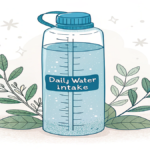Water is key to health, and knowing how much to drink is important. The U.S. National Academies suggest about 15.5 cups daily for men and 11.5 for women. Your activity level, health, and the weather also affect how much you need.
To avoid dehydration, drink fluids regularly. Foods with a lot of water also help. Drinking enough water is good for your metabolism and can help with weight loss.
Understanding Hyponatremia
Hyponatremia is a serious condition caused by too much water. It happens when your blood’s sodium levels drop too low. This can cause your cells to swell.
Several things can lead to this imbalance. These include:
- Medications that affect your kidneys.
- Heart, kidney, or liver problems.
- SIADH, which makes you hold onto water.
- Excessive vomiting or diarrhea.
- Hormonal changes.
- Using drugs like Ecstasy.
Hyponatremia can be mild or severe. Mild symptoms include nausea and headaches. However severe cases can cause brain swelling, coma, or even death.
Women before menopause are more likely to suffer brain damage from hyponatremia. Symptoms are similar to water intoxication, like lung congestion, seizures, and confusion. This shows why it’s important to drink water in moderation.
To stay safe, you should:
- Deal with any health issues that might lead to hyponatremia.
- Watch for early signs and symptoms.
- Be careful when you’re doing intense activities.
- Use sports drinks to replace lost electrolytes during long workouts.
- Drink water in amounts that fit your body’s needs.
Risk Factors for Water Intoxication
Risk Factors for Water Intoxication:
- Demographic Vulnerability: Older adults are more likely to get hyponatremia, which can lead to water intoxication.
- Medication Influence: Some drugs, like thiazide diuretics and Ecstasy, can increase the risk of hyponatremia.
- Health Conditions: Certain diseases, such as kidney disease and heart failure, can also raise the risk of water intoxication.
Environmental and Lifestyle Factors:
- Elevated Fluid Needs: Intense exercise and hot weather can make you need more water.
- Life Stages: Pregnant or breastfeeding women may need to drink more water.
Causes and High-Risk Groups:
- Overhydration Causes: Drinking too much water, due to medical conditions or drugs, can cause overhydration. This is a risk for endurance athletes and people with certain health issues.
- Vulnerable Populations: Marathon runners, military trainees, and those with eating disorders or using recreational drugs are at high risk for water intoxication.
Additional Considerations:
- Thirst Mechanism Alteration: Some conditions and drugs can make you thirsty more. This includes schizophrenia, MDMA use, and certain diabetes types.
Causes of Water Intoxication
- Water Retention: Medical conditions like congestive heart failure and liver disease can cause water retention.
- Child Abuse: Sadly, water intoxication can also be a result of child abuse.
How Much Water Is Too Much?
Finding out how much water is too much is key to avoiding water intoxication. The U.S. National Academies suggest 15.5 cups (3.7 liters) for men and 11.5 cups (2.7 liters) for women daily. But, these amounts can vary based on many factors like sex, weather, and health.
Watch your urine color to check if you’re hydrated. Aim for pale yellow. Darker urine means you’re dehydrated, and colorless urine might mean you’re drinking too much. Dehydration can cause fatigue and confusion, while too much water can lead to nausea, vomiting, and even seizures or death in severe cases.
Here are some tips for drinking the right amount of water:
- Before Exercise: Drink 14-22 ounces of fluid two to three hours before exercising.
- During Exercise: Let your thirst guide you, considering the activity’s intensity and length.
- Daily Fluid Intake: Aim for 78-100 ounces (about 9-13 cups) of fluids daily. Adjust based on your sex, climate, and activity level.
- Hydration Check: Use urine color as a guide. Pale yellow is best, darker means you need more, and colorless might mean you’re drinking too much.
- Endurance Athletes: Weigh yourself before and after events to see how much water you lost. This helps you know how much to drink to rehydrate.
By following these tips, you can stay hydrated without overdoing it.
Prevention and Treatment
To avoid water intoxication and manage hyponatremia, take these steps:
Prevention Strategies:
- Limit fluid intake to 1 to 1.5 liters per hour during intense activities like marathons or long-distance cycling.
- Drink fluids based on your thirst, balancing water with sodium and sweat loss.
- Manage any health conditions that might lead to hyponatremia well.
Treatment Protocols:
- In acute hyponatremia, aim to normalize sodium levels within 24 hours. The most important changes happen in the first few hours. This is because the risk of osmotic demyelination syndrome (ODS) is linked to the daily rate of change in serum sodium, not hourly.
- Start with a 3% saline 50 ml bolus for symptom-free patients and a 3% saline 100 ml bolus for those with symptoms. You can give up to two more 100 ml doses if needed, but no more than 300 ml total.
- Keep a close eye on patients; check them hourly for any changes in mental status or symptoms. This ensures timely action and prevents complications.










